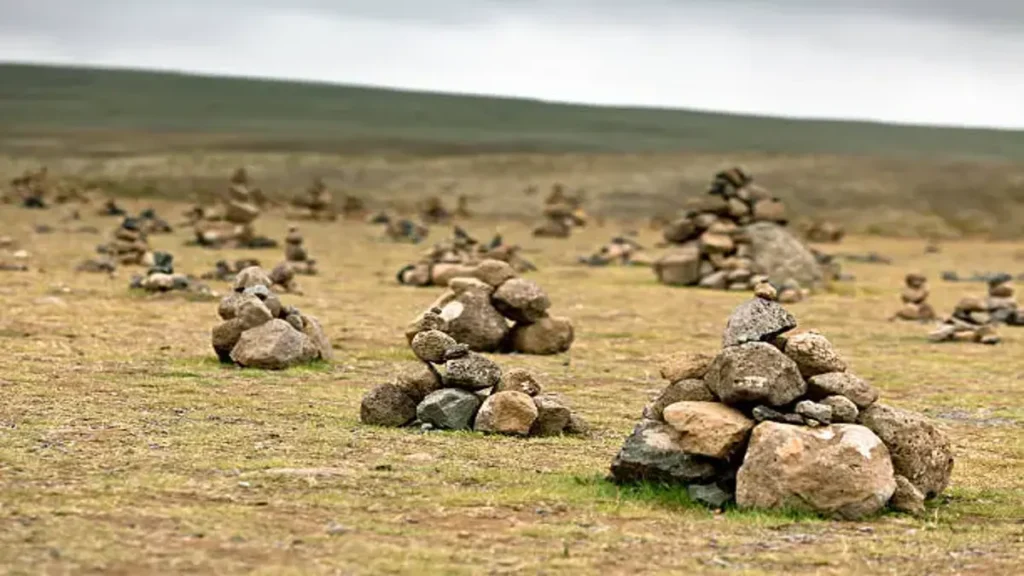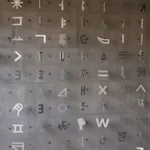If you searched “varða” hoping for a crisp answer, here it is in the first 100 words: a varða is a deliberately stacked pile of stones — a cairn — used historically across Northern Europe and beyond as a trail marker, boundary sign, memorial, or signal. This article traces the varða’s long life: from Bronze Age fieldmarks to Viking-age wayfinding; from seasonal shepherd trails to contemporary hiking culture and land-art installations. You will find practical guidance on how to read and (responsibly) build one, the folklore and metaphors that shape its meanings, legal and conservation concerns, and why these modest piles of rock keep returning in human narratives about direction, memory and belonging.
A small thing that points the way
A varða is almost comically simple: stones stacked until they make a visible heap. Yet simplicity is its strength. A line of varður (plural) on a ridge can be read from miles away; a solitary varða on a knoll can signify a burial place, a property corner, or a warning. Across cultures and centuries, people have learned to see these stone markers as anchors in landscapes that otherwise change with weather, seasons and travel.
What makes a varða distinct from random rocks on the ground is intention: the stones are gathered and arranged to create a deliberate, visible form. That intention is a human voice cast into the terrain, saying: “This way,” “This is important,” “Remember,” or “Beware.” We still respond to that voice because it is shorthand for social coordination in the outdoors.
Origins and archaeology: from pragmatic markers to ritual stones
Archaeologists find stone piles in varied contexts. Some varður date to prehistoric times, when societies used raised stones to mark graves or territory, or as aids for hunting and navigation. In the North Atlantic and Scandinavian archaeological record, cairns appear alongside burial mounds, trackways and ritual sites. Their construction materials are local — the bedrock and fieldstones at hand — which makes them both ubiquitous and place-specific.
In maritime contexts, a varða placed near a headland or harbor could guide sailors; inland, varður often mark passes, water sources or safe routes across bogs and snowfields. Over time, the varða’s practical function and ritual role often merged: a cairn that once guided travelers might later acquire a memorial role, and vice versa. That mutability — the ability to mean first this, then that — is part of the varða’s endurance.
Varða across cultures: names and variants
Different languages and cultures have distinct words and traditions for the same basic object. In Old Norse, the term varða or varðr carries both the literal and poetic senses — a pile of stones, a guardian, a watch. Scottish Gaelic uses “càrn,” the English “cairn” is widely adopted, and similar stone markers appear under varied names across Asia, the Americas and Africa. In each setting the material is local and the social practice adapts to needs — navigation in a windswept fjord, marking a transhumance trail, or memorializing a loved one.
Even where the word changes, the communicative grammar of the stone pile is similar: size, location, and arrangement convey different messages. A tall, conspicuous varða on a skyline speaks to route marking; a low, carefully shaped cairn at a summit may signify achievement or act as a place to leave offerings.
Folklore and meaning: guardians, spirits and stories
Stone piles gather stories as neatly as they gather stones. In Northern legend, cairns are sometimes associated with spirits — guardians of tracks or boundary watchers who claim a measure of the landscape. In Icelandic tradition, for example, varður could be linked to the spiritual or prophetic — the word carries connotations of watching and warding. In Scotland, cairns sometimes marked battlefields or were places of oath-making. In many cultures, leaving a stone on a cairn is an act of participation in a long chain of travelers: a small claim of presence and reciprocity.
Because varður so often occupy liminal spaces — passes, ridges, shorelines — they also function as metaphors for thresholds: between life and death, home and outside, safety and hazard. Writers and poets have long used the narrow geometry of the cairn — a small base holding a higher point — as a symbol for endurance and collective effort.
Quote: “A varða is a tiny cathedral of the ground — built not for gods but for direction.”
Practical functions: navigation, boundaries and memory
The varða’s primary historic utility is navigation. On moors, in snowfields, or along featureless tundra, a line of varður marks a safe route. They are deliberately sited at intervals on skyline or ridgelines so that a traveler can follow a chain of markers when visibility permits. In snow and fog, even low-profile varður can cast a silhouette that readjusts a traveler’s sense of direction.
Varður also serve as boundary markers: property lines and parish limits have been set or reinforced by cairns for centuries. And because the stones endure, varður can become memory devices—small durable monuments that record a name, a death, or a communal event when other materials would have long since decayed.
How to read a varða: what size, shape and placement mean
Reading a varða is partly intuitive and partly cultural — you must learn the local codes. Still, general guidelines help:
• Location: Varður on ridges or skyline mark routes; those at hollows or springs may indicate water or safe descent.
• Size: Larger or taller cairns often mark more important points (passes, summits) or were built by larger groups.
• Orientation: Some cairns have a deliberate face or flat side pointing toward the route or a notable feature like a summit.
• Associations: Nearby items (pieces of cloth, coins, small crosses) can signal memorial use rather than navigational.
• Spacing: A chain of varður at regular intervals suggests trail marking; scattered single cairns suggest isolated significance.
Learning local practice is essential: in some mountain cultures, for instance, a small cairn at a junction is a plea for safe passage, while nearby stone arrangements might be ritual markers.
How to make a varða responsibly: ethics and best practice
Building or adjusting a varða is attractive for travelers who want to leave a sign, help others, or participate in tradition. Yet there are strong reasons for restraint. In many protected habitats, moving stones disrupts lichens, invertebrate habitats and soil stability. Erecting new cairns can mislead hikers, encourage off-trail erosion, and gradually alter landscapes. For these reasons, conservation authorities often discourage building new cairns except where established tradition or safety requires them.
If you decide to build or repair a varða in a place where it is appropriate and safe, follow these principles:
• Do not create new cairns in undisturbed environments. New cairns in fragile ecosystems mislead and damage.
• Repair rather than build anew: if a historical varða is damaged and restoration is permitted, collect stones from immediate vicinity rather than importing new material.
• Keep size modest: avoid creating conspicuously large features that change skyline or visual character.
• Respect cultural context: if the varða marks a grave or sacred place, do not disturb it.
• Use natural stones only: avoid using cement, carved markers, or foreign materials that alter the cairn’s character.
Quote: “A responsible hand on a varða is a promise to the next traveler: I did not make your way harder.”
Table — Varða types, functions and key considerations
| Varða Type | Typical Location | Primary Function | Conservation Note |
|---|---|---|---|
| Route marker | Ridgelines, skyline | Wayfinding across featureless terrain | Repair existing, avoid creating new cairns |
| Summit cairn | Mountain tops, high points | Denote summit or accomplishment | Often culturally significant; do not dismantle |
| Boundary cairn | Parish lines, property corners | Mark legal or social limits | Historical; consult local records before altering |
| Memorial cairn | Gravesites, commemorative spots | Memory and ritual | Sensitive — treat with respect and restraint |
| Warning cairn | Near hazards, cliffs | Signal danger | Should be maintained by local authorities where possible |
| Stacked art / installations | Public spaces, galleries | Aesthetic or symbolic work | Use non-invasive methods and permissioned sites |
Varða in modern hiking culture: markers, memorials, and social media
With the rise of recreational hiking, varður have become part of visitor experience. Summit cairns often accumulate coins, ribbons, and tokens left by climbers. People photograph cairns as proof of achievement and share them on social media, giving these small stone piles a new layer of contemporary meaning: they are both functional and photographic props.
This popularity brings dilemmas. Well-meaning hikers may keep adding stones to make their mark, enlarging cairns into unnatural monuments and encouraging others to follow. In some heavily visited areas, overbuilt cairns alter the skyline and create ecological problems; in others, visitor-constructed cairns have become part of officially recognized landscape character. Park managers must weigh visitor expectations, cultural practice, and conservation science when deciding whether to allow or discourage cairn-building.
Legal and land-management perspectives
Different jurisdictions have distinct rules. In many national parks and nature reserves, creating or moving cairns is prohibited because it alters natural heritage and misleads other users. Where varður mark legal boundaries, interfering with them may carry legal consequences. Moreover, in regions where varður have been associated with cultural heritage—burial cairns or ritual structures—interference can be an affront to descendant communities and their rights.
Before building, moving or using a varða as a marker, check local park regulations and respect signage. When in doubt, leave stones where you found them and rely on established trails and official waymarking systems maintained by land managers.
Ritual, commemoration and collective memory
Cairns as memorials have a distinct set of cultural practices. In some communities, walking to a varða and adding a stone is a ritual of mourning: each stone a small witness to memory. In other settings, cairns mark events, battles or collective achievements. The act of building a varða for ritual reasons is an act of social cohesion — people physically contribute a piece to a shared monument.
Because memorial cairns often involve human remains or sacred sites, they are particularly sensitive. Anthropologists and local communities have documented that the removal or desecration of such cairns can cause deep hurt. For anyone encountering a cairn that appears to be a memorial, the correct response is reverence and non-interference.
Quote: “To place a stone is to say: I was here; I remember.”
Varða in art and architecture: when stones become statement
Artists and designers have long used stone stacking as aesthetic practice. Land artists working at the scale of hills or coastlines incorporate cairn forms to explore time, memory and the human mark on landscapes. In galleries and public art, stacked stones can be deliberately ephemeral works that call attention to process and temporality. Unlike vernacular varður, art cairns are curated and often sited with permission and environmental safeguards, but they nonetheless raise similar questions: who owns the right to shape public space? How does a human-made marker change our experience of nature?
Building techniques: how to stack stones that last
If you are working on a permitted restoration or building a cairn in a context where it is appropriate (for instance, repairing a well-established route marker), use these durable techniques:
• Foundation: Find a stable base. Use larger, flattened stones at the bottom to prevent settling.
• Interlock: Place each stone so it nests against others; avoid loose balancing that invites collapse.
• Taper: Build with a slightly wider base and narrower top to resist wind and erosion.
• Compactness: Keep the mass compact; spaces between stones reduce stability.
• Top marker: Use a distinctive topstone to signal intentional construction.
Careful stacking minimizes future maintenance and reduces the chance of inadvertent collapse that could mislead or injure others.
Safety and trail navigation: varður and modern signage
Modern trail systems rely on blazes, painted markers, and signage to ensure safe navigation. In wilderness areas without official markers, varður remain critical. However, hikers should use varður as one input among many: maps, compass, GPS and local knowledge are essential. Over-reliance on stone piles—especially ones that may have been moved—can lead to disorientation.
Good practice for hikers:
• Carry a map and compass and learn how to use them.
• Use varður as confirmation, not sole guidance.
• Report damaged or misleading cairns to park authorities when safe to do so.
• Avoid leaving new cairns in sensitive areas; stick to established trails.
Case studies: varður that shaped routes and stories
Consider the high passes of the North Atlantic islands and the Scottish Highlands: lines of cairns historically guided sheep and shepherds across treacherous moors. In Icelandic sagas—and later travel narratives—varður appear as beacons the sagas’ travellers rely upon. In mountain rescue cases, a damaged or absent varða has sometimes contributed to confusion in poor weather; conversely, a well-maintained line of cairns has guided lost parties to safety. These case studies underline the varða’s combined roles as practical tool and cultural artifact.
The future of the varða: stewardship, interpretation and education
As outdoor recreation expands and climate shifts alter landscapes, the future of varður depends on engaged stewardship. Park authorities and local communities increasingly create interpretive materials that explain the history and significance of cairns, instruct visitors about responsible behavior, and, where appropriate, maintain key markers for safety. Educational programs that teach how to read cairns, the ethics of not building new ones, and the cultural contexts of memorials help preserve both the physical and symbolic landscapes that varður occupy.
Conclusion: small stones, large meanings
The varða’s strength lies in its modesty. Made from what is at hand, it performs a wide array of social tasks: mapping routes, marking memory, asserting boundaries. It is a form whose grammar is stone and sky — built by hands that understood the landscape’s hazards and needs. In an age of satellite navigation and digital wayfinding, varður continue to matter because they compress human intent into durable markers that survive storms and seasons and because they carry collective stories that technology does not replace.
If you walk into wild country and find a varða, pause. Consider its place in a wider chain of labor and memory. If you must interact with it—repairing a collapsed route marker or adding a stone at a memorial—do so with humility and local knowledge. The varða is both a practical instrument and a communal text; read it carefully, and you will find directions, histories, and the small, patient architecture of people who passed that way before you.
Frequently Asked Questions (FAQs)
Q1: What does the word “varða” actually mean?
Varða is an Icelandic and Old Norse word meaning “stone cairn” or “watch.” It describes a human-made pile of stones that serves as a marker for navigation, boundary, or commemoration. The word also carries a poetic undertone—signifying protection, guardianship, and observation—making it as symbolic as it is functional.
Q2: Are varður (plural) found only in Iceland or Scandinavia?
No. While the tradition is strong in Iceland, Norway, and the Faroe Islands, similar stone markers exist worldwide. From Scottish cairns and Irish boundary mounds to Andean apachetas and Himalayan mani stones, people across cultures have used stacked stones for guidance, memory, and spirituality. The Icelandic varða simply represents one regional expression of a global idea.
Q3: Is it legal or ethical to build a new varða while hiking?
In most protected landscapes, building new cairns is discouraged or prohibited. They can mislead travelers, disturb ecosystems, and damage fragile habitats. Hikers are encouraged to preserve existing historical cairns but avoid creating new ones. If a cairn is part of a designated trail, it should be maintained carefully and only with local permission.
Q4: What materials or structure make a proper varða?
A traditional varða uses natural, uncut stones from its immediate surroundings. It should have a wide, stable base, a tapering body, and a distinctive topstone for visibility. Builders interlock stones to resist weather and avoid cement or artificial stabilizers. The structure’s strength comes from balance and careful placement, not from adhesives or foreign materials.
Q5: What symbolic or cultural meanings are attached to varður today?
Modern hikers and artists often see varður as symbols of direction, endurance, and community. Many travelers add a single stone to a cairn as a gesture of respect or participation in a shared tradition. In literature and art, the varða often represents memory and moral guidance—a humble yet enduring metaphor for humanity’s attempt to leave order and meaning amid wild landscapes.







